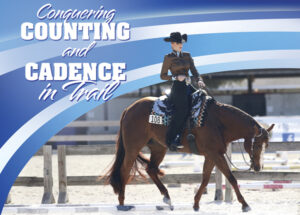Conquering Counting and Cadence in Trail
Click here to read the complete article
194 – September/October, 2022
Winning Trail runs look fluid and effortless: the horse and rider seem in sync; obstacles are navigated with style and ease; and the quiet concentration of both horse and rider permeate the air. But those high scoring rides have a lot going on beneath their cool appearances: thoughtful strategy, precise riding of every stride, and–perhaps surprisingly–lots and lots of math and counting.
Counting serves several purposes in trail. Counting the number of steps a horse should take between certain poles and the number of strides between obstacles, for example, is crucial to avoid penalties. Counting can also help a rider keep cadence, just as in a western riding pattern, and it can help the horse and rider take a pause between obstacles to set themselves up for success as they continue their pattern.
Kelly McDowall
“Trail is really a math test and a little luck. If you can do the math right for your horse on that day, he’s a good mover and you stay on pattern, then you’ve got a good chance of winning a prize,” says Kelly McDowall of Franktown, Colorado–who owns and operates McDowall Quarter Horses with his wife, Marnie. With his acute understanding of the importance of stride length and counting strides and steps, he has shown and coached many Congress, NSBA and AQHA World Champion Trail horses over the past twenty years. He’s currently showing Moonlite Madnez and Flat Out Lopin.
Knowing how trail courses are set and obstacles are measured is what makes counting strides an integral part of success in trail. Exhibitors and trainers know that lope-overs will be six feet apart, trot-overs will be three feet, and walk-overs will be two. But just knowing those measurements and then counting strides will not add up to immediate success. The horse must know how to move with cadence in exactly those measurements; and for most, that’s far from easy.
Click here to read the complete article
194 – September/October, 2022











